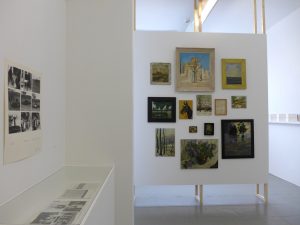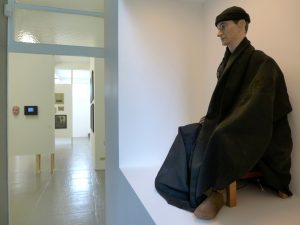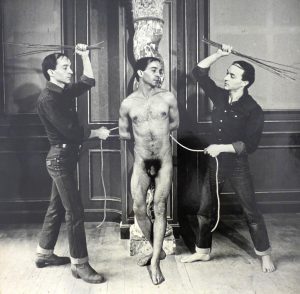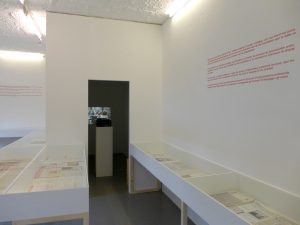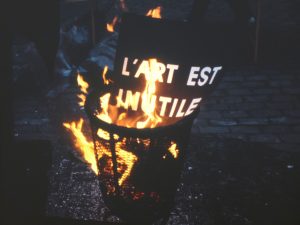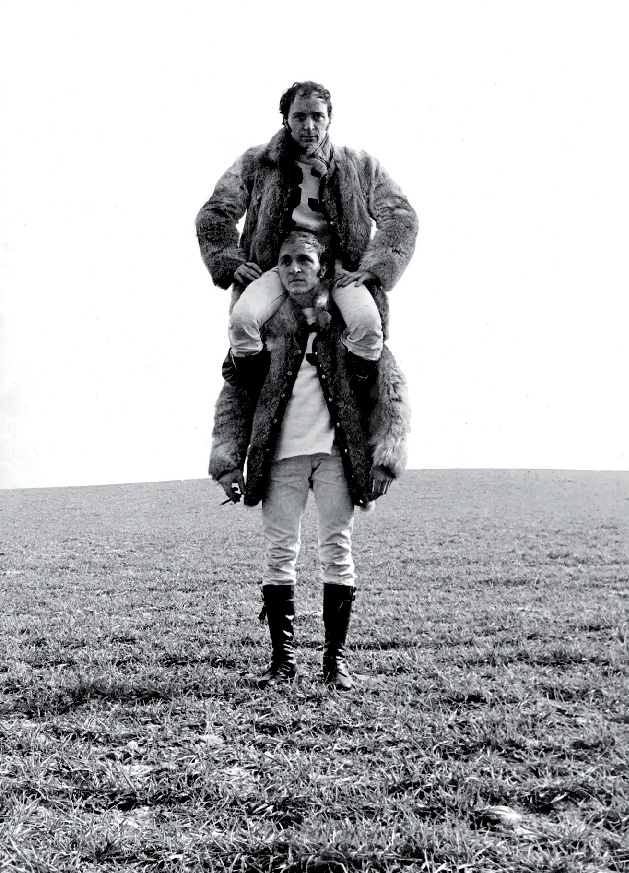La morte addosso
De (anonieme) kunstproductie van Alessandro en Schède (1966-1980)
03.05.2014 — 29.06.2014
curatoren: Koen Brams, Ulrike Lindmayr and Dirk Pültau
scenografie: Hans Wuyts
[NL]
De tentoonstelling La morte addosso brengt voor het eerst een representatief overzicht van het vroege werk van de Italiaanse kunstenaar Alessandro Filippini (°1946, Rome). Tevens wordt ruime aandacht besteed aan de activiteiten van het kunstenaarscollectief Schède, waarvan Alessandro Filippini, samen met Sergio Domian en Mario Ferrucci, deel uitmaakte.
Alessandro
Alessandro Filippini studeert aan de Academie voor Schone Kunsten te Rome en reist in 1964 naar België, waar hij studies aanvat aan de Ecole Nationale Supérieure d’Architecture et des Arts Visuels (ENSAAV, La Cambre/Ter Kameren, Brussel). Reeds tijdens zijn Brusselse academietijd realiseert Filippini sculpturen die hij Solidificazioni (‘verhardingen’) noemt. Het zijn ensembles, die bestaan uit alledaagse objecten die hij met gips ‘verhard’ en in één kleur beschilderd heeft. Met de Solidificazioni geeft de jonge kunstenaar voor het eerst uitdrukking aan twee obsessies die hem het volgende decennium in toenemende mate zullen bezighouden: enerzijds het meedogenloze werk van de tijd, die in de Solidificazioni letterlijk ’tot stilstand’ is gekomen; anderzijds de abstrahering van ‘het leven’, dat door de uniforme kleur onder één noemer is gebracht. In één specifieke Solidificazioni, een versteven doek dat over een schilderij gedrapeerd lijkt, komt een derde preoccupatie van Filippini aan het licht: de kritiek op en negatie van het (geautoriseerde) kunstwerk.
Als Alessandro in 1973 de fotomontage La morte addosso maakt, verbindt hij het thema van de onverbiddelijke eindigheid van het leven met de fascinatie voor de gespletenheid van het menselijke individu. De verdubbeling van Alessandro, de protagonist in La morte addosso, is slechts de eerste stap in een reflectie over identiteit. In de daaropvolgende fotomontages, zoals Histoire dans le parc (1974) en L’histoire du Christ (ca. 1975-1976), neemt Alessandro immers álle rollen op zich. Het motief van de dubbelganger krijgt zijn apotheose in Dialogo con se stesso: een marionet, die helemaal op Alessandro lijkt en met diens stem absurde of existentiële boodschappen de wereld in stuurt. Scorie della vita, een glazen bokaal die hij sinds 1971 met zijn eigen afgeknipte vinger- en teennagels vult, vormt zonder meer het unheimliche hoogtepunt in Alessandro’s gedachten over de verbrokkeling van het menselijke subject.
Schède
In 1974 formeert Alessandro samen met Sergio Domian en Mario Ferrucci, twee eveneens Italiaanse, in Brussel residerende kunstenaars, het kunstenaarscollectief Schède, dat zij ooit ironisch zouden omschrijven als ‘conseil supérieur des musées anonymes et éphémères’.
Schède organiseert twee zogenaamde ‘operaties’, die een kritische houding verraden jegens het kunstsysteem. De eerste is de uitgave van het gelijknamige tijdschrift, dat bestaat uit ‘fiches d’opérateurs anonymes’, werken van operatoren die hun werk presenteren zonder het te signeren. Van het tijdschrift, dat gratis wordt verspreid in Europa en de Verenigde Staten, verschijnen 12 nummers, van november 1974 tot en met oktober 1975. De tweede ‘operatie’ is zo mogelijk nog ambitieuzer en is getiteld Schède – Itinérante et Ephémère. Het betreft een rondreizende tentoonstelling waaraan in totaal 122 kunstenaars participeren en die achtereenvolgens in Gent, Brussel, Moncton (Canada) en Antwerpen te zien is. Op de sluitingsdag van de vierde expo, 6 juni 1980, worden – zoals tevoren met alle deelnemende kunstenaars overeengekomen – alle geëxposeerde werken onder toezicht van de gerechtsdeurwaarders Raymond en Michel Vyt vernietigd.
Met Itinérante et Ephémère komt er een einde aan de activiteiten van Schède én aan het vroege werk van Alessandro.
Als afsluiting van het tentoonstellingsproject organiseerde LLS 387 op 7 juni een namiddag met gesprekken en drie screenings (“Le stylo qui saigne”, 1972; “Evolution bureau”, 1972; “Mort, résurrection et retour parmi les hommes”, 1973): Dirk Pültau in gesprek met Alessandro Filippini over de drie kortfilms; Koen Brams in gesprek met Bernard Marcelis over zijn samenwerking met Alessandro Filippini en Schède; Koen Brams in gesprek met Wim Van Mulders over zijn contacten met Alessandro Filippini en Schède; Dirk Pültau in gesprek met Mario Ferrucci over het ideeëngoed van Schède.
Met dank aan alle bruikleengevers Mario Ferrucci, Alessandro Fillippini en het M HKA en aan Christine Bastin, Nadia Bijl, Martin Blank, Laura Coosemans, Yirka De Brucker, Manu Devriendt, Liliane De Wachter, Jacques Evrard, Chris Gillis, Karolien Jansen, Andrea Kränzlin, Rufus Michielsen, Francine Moyé, Ria Pacquée, Cateau Robberechts, Mima Schwahn en Sietske Van Aarde.
Met de ondersteuning van de Vlaamse overheid. Gesponsord door Duval Moortgat.
[FR]
L’exposition La morte addosso propose pour la première fois un aperçu représentatif des œuvres de la première période de l’artiste italien Alessandro Filippini, né en 1946 à Rome. Parallèlement, elle accorde une large place aux activités du collectif Schède dont Filippini faisait partie aux côté de Sergio Domian et Mario Ferrucci.
Alessandro
Alessandro Filippini fait ses études à l’Académie des Beaux-Arts de Rome. Arrivé en 1964 en Belgique, il entreprend de suivre des cours à l’École Nationale Supérieure d’Architecture et des Arts Visuels (ENSAAV, La Cambre/Ter Kameren, Bruxelles). Dès cette période d’apprentissage, il crée des sculptures qu’il baptise Solidificazioni. Il s’agit d’ensembles composés d’objets du quotidien qu’il « solidifie » avec du plâtre et qu’il peint en retenant une seule couleur. Ces Solidificazioni permettent au jeune homme de traduire pour la première fois deux obsessions qui le retiendront toujours plus au cours de la décennie suivante : d’une part, l’œuvre implacable du temps, ici littéralement « figé » ; d’autre part, l’abstraction de « la vie », réduite à un seul dénominateur par le moyen d’une couleur uniforme. Un Solidificazione spécifique, tissu raidi qu’on dirait drapé sur une peinture, met en lumière une troisième préoccupation de l’artiste : la critique et la négation de l’œuvre (autorisée).
Réalisant en 1973 le photomontage La morte addosso, Alessandro relie le thème de la finitude inexorable de l’existence à la fascination qu’exerce le dédoublement de tout individu. La duplication d’Alessandro, protagoniste de La morte addosso, n’est que la première étape d’une réflexion sur l’identité. Dans les photomontages ultérieurs, Histoire dans le parc (1974) et L’histoire du Christ (vers 1975-1976), il joue en effet tous les rôles. Le thème du double trouve son apothéose dans Dialogo con se stesso, une marionnette qui ressemble en tout point à Alessandro et qui, avec sa voix, répand dans le monde des messages soit absurdes, soit existentiels. Scorie della vita, un bocal en verre qu’il remplit depuis 1971 de coupures d’ongles de ses doigts et orteils, constitue sans aucun doute le lugubre point culminant de sa pensée eu égard au morcellement du sujet humain.
Schède
En 1974, Alessandro fonde avec Sergio Domian et Mario Ferrucci, deux autres artistes italiens résidant à Bruxelles, le collectif Schède, qu’ils allaient décrire non sans ironie comme « le Conseil Supérieur des Musées anonymes et éphémères ».
Schède organise deux « opérations » qui trahissent une attitude critique vis-à-vis du système artistique. La première consiste dans l’édition d’une revue éponyme se composant de « fiches d’opérateurs anonymes », autrement dit des travaux non signés présentés par leurs créateurs. Douze numéros paraissent, distribués gratuitement en Europe et aux États-Unis, de novembre 1974 à octobre 1975. Intitulée Schède – Itinérante et Éphémère, la deuxième « opération » se révèle peut-être plus ambitieuse encore. Il s’agit d’une exposition itinérante à laquelle participent en tout 122 artistes. Elle est organisée successivement à Gand, Bruxelles, Moncton (Canada) et Anvers. Lors de la clôture de la quatrième exposition, le 6 juin 1980, toutes les œuvres sont détruites – avec l’accord préalable des artistes – sous la supervision des huissiers de justice Raymond et Michel Vyt.
Itinérante et Éphémère marque la fin des activités de Schède et de l’œuvre de jeunesse d’Alessandro.
En conclusion du projet d’exposition, LLS 387 organisa le 7 juin une séance d’entretiens avec projection de trois films (“Le stylo qui saigne”, 1972; “Evolution bureau”, 1972; “Mort, résurrection et retour parmi les hommes”, 1973). Le programme de cet après-midi se composait d’un entretien entre Dirk Pültau et Alessandro Filippini au sujet des trois courts métrages; un entretien entre Koen Brams et Bernard Marcelis sur la collaboration de ce dernier avec Alessandro Filippini et Schède; un entretien entre Koen Brams et Wim Van Mulders au sujet des contacts entretenus par ce dernier avec Alessandro Filippini et Schède; un entretien entre Dirk Pültau et Mario Ferrucci sur la pensée développée par Schède.
Merci à Mario Ferrucci, Alessandro Fillippini et le M HKA et de Christine Bastin, Nadia Bijl, Martin Blank, Laura Coosemans, Yirka De Brucker, Manu Devriendt, Liliane De Wachter, Jacques Evrard, Chris Gillis, Karolien Jansen, Andrea Kränzlin, Rufus Michielsen, Francine Moyé, Ria Pacquée, Cateau Robberechts, Mima Schwahn et Sietske Van Aarde.
Avec le soutien de Vlaamse overheid et Duvel Moortgat.
[EN]
La morte addosso is the first representative overview of the early work of the Italian artist Alessandro Filippini (b. 1946, Rome). The spotlight is also turned on the ‘operations’ of Schède, the artists’ collective formed by Alessandro and fellow-Italians Sergio Domian and Mario Ferrucci.
Alessandro
Alessandro Filippini was trained at the Academy of Fine Arts in Rome; in 1964 he came to Belgium to continue his studies at the Ecole Nationale Supérieure d’Architecture et des Arts Visuels (ENSAAV, La Cambre/Ter Kameren, Brussels). It was while he was at the Brussels art school that he produced the sculptures he called Solidificazioni (‘solidifications’) – assemblages of everyday objects ‘solidified’ with plaster and painted in a single colour. The Solidificazioni were Filippini’s earliest expression of two obsessions that would increasingly engage his thinking in the next decade: on one hand the remorseless work of time, which in the Solidificazioni has literally come to a standstill; on the other the abstraction of ‘life’, which via the uniform colour has been subsumed under a single denominator. One particular Solidificazione, a stiffened piece of cloth that seems to be draped over a painting, brings a third preoccupation of Filippini’s to light: the critique on and negation of the (authorized) work of art.
When Alessandro produced the photomontage La morte addosso in 1973, he linked the theme of the implacable finiteness of life and the fascination with the multipersonality of the human individual. The doubling of Alessandro, the protagonist in La morte addosso, is only the first step in a reflection on identity. In subsequent photomontages, such as Histoire dans le parc (1974) and L’histoire du Christ (c.1975-1976), he took on all the roles himself. The doppelganger motif reaches its apotheosis in Dialogo con se stesso: a puppet that looks exactly like Alessandro and mouths absurd or existential messages in his voice. Scorie della vita, a glass jar which he has been filling with his own fingernail and toenail clippings since 1971, is undoubtedly the somewhat unsettling highlight of his reflections on the dissemination of identity.
Schède
In 1974 Alessandro and two fellow-Italians who were also living in Brussels, Sergio Domian and Mario Ferrucci, started an artists’ collective called Schède, which they would ironically describe as ‘conseil supérieur des musées anonymes et éphémères’.
Schède organized two ‘operations’ that evinced a critical attitude towards the art system. The first was the issuing of a magazine, also entitled Schède, which consisted of ‘fiches d’opérateurs anonymes’, works by operators who presented their work without signing it. Between November 1974 and October 1975 twelve editions of the magazine appeared and were distributed free of charge in Europe and the US. The second and even more ambitious ‘operation’ was entitled Schède – Itinerant and ephemeral – a travelling exhibition in which a total of 122 artists took part and which was seen successively in Ghent, Brussels, Moncton (Canada) and Antwerp. On the final day of the fourth exhibition, 6 June 1980 – and as previously agreed by all the artists involved – every one of the exhibited works was destroyed in the supervisory presence of court bailiffs Raymond and Michel Vyt.
Itinerant and ephemeral marked the end of Schède’s activities and also the end of the early work of Alessandro.
To conclude the exhibition project LLS 387 organised on 7th of June one afternoon with talks and screenings (“Le stylo qui saigne”, 1972; “Evolution bureau”, 1972; “Mort, résurrection et retour parmi les hommes”, 1973): Dirk Pültau in conversation with Alessandro Filippini about the three shortfilms; Koen Brams in conversation with Bernard Marcelis about his collaboration with Alessandro Filippini and Schède; Koen Brams in conversation with Wim Van Mulders about his contacts with Alessandro Filippini and Schède; Dirk Pültau in conversation with Mario Ferrucci on the ideas of Schède.
With thanks to all the lenders Mario Ferrucci, Alessandro Fillippini and the M HKA and to Christine Bastin, Nadia Bijl, Martin Blank, Laura Coosemans, Yirka De Brucker, Manu Devriendt, Liliane De Wachter, Jacques Evrard, Chris Gillis, Karolien Jansen, Andrea Kränzlin, Rufus Michielsen, Francine Moyé, Ria Pacquée, Cateau Robberechts, Mima Schwahn and Sietske Van Aarde.
With the support of the Flemish Government. Sponsored by Duvel Moortgat.
